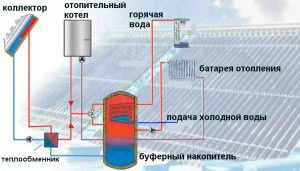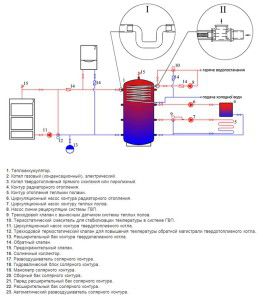How to increase the efficiency of the heating system? In addition to standard methods, you can make a small upgrade. It consists in installing additional tanks that can perform various functions. In this case, it is important to choose the right capacity for the heating system: buffer, storage, storage. Efficiency and the possibility of organizing hot water supply will depend on this.
Buffer tank for heating
It is a barrel, inside of which there is a coil - it connects to the heating main. The material of its manufacture is copper or steel. Energy from the heat carrier through the surface of the coil is transferred to the water in the tank.
Design specifics
At first glance, the storage tank for heating does not have special advantages. However, a deep analysis reveals that the relevance of its installation in an autonomous network is an indisputable factor. What functions does this design perform?
- Transfer of thermal energy to water, which can be used for hot water supply;
- Increasing the duration of heating even when the boiler is off. To do this, one of the pairs of nozzles is connected to the system through two or three-way valves. In this case, the buffer capacity of the heating system will mix the cooled coolant with the hot water stored in it;
- Use of heated water for low-temperature heating circuits - water floor heating.
Such opportunities are explained by design features. All factory buffer tanks for heating have additional insulation circuits. That minimizes the heat transfer of heated water. Also, the nozzles have different diameters for switching with heating circuits.
When choosing a factory model of the capacity of the heating system (buffer, storage or storage), you need to pay attention to the number of pipes - from 2 to several tens. Their optimal number depends on the contours in the system.
Buffer capacity calculation
Any capacity of the heating system is primarily characterized by volume. To calculate it, it is recommended to use special programs. If this is not possible, you can make rough calculations yourself. The heat capacity of water is 4.187 kJ / kg * C. If the heating system has a rated power of 24 kW / h, then the storage tank for heating must support the operation of the system for 4-8 hours after turning off the boiler. It is necessary to calculate the volume for the hourly heating operation. In this case, the temperature difference should be 70-45 = 25 ° C. Knowing that 1 kW / h is 3600 kJ, you can calculate the capacity:
(24 * 3600) / (4.187 * 25) = 825 kg or 0.825 m³
This is only an approximate calculation scheme, since each capacity of the heating radiator has a number of additional characteristics - heat loss, temperature and humidity in the room, type of heating (gravitational or forced circulation).
What to consider when choosing a buffer tank for a heating system?
- Its useful volume;
- The area of the heat exchange element;
- Type of heat exchanger - coil or tank in the tank. The latter is preferable, since a similar design increases the area of water heating in the tank.
| Model | Features | Price, thousand rubles |
| Austria Email PSF 800 l | Thermal insulation | 49,175 |
| Bosch BST 1000/80 Sr | Coil | 79,8 |
| Drazice NAD 1000 V1 | Without thermal insulation | 23,2 |
The price of the storage tank for heating is high - the simplest 800 model costs from 35 thousand.rub., so often try to do it yourself.
For heating a small private house, installation of a tank of less than 500 l is unprofitable. She will not be able to accumulate the right amount of thermal energy.
DIY thermal battery
The complexity of manufacturing buffer tanks for heating is to create reliable thermal insulation. To do this, you can not use a conventional barrel or a container similar to it. In addition to this parameter, the capacity of the heating radiator must withstand the load of water on the walls and possible hydraulic shocks.
The simplest design is a cube, inside of which there is a U-shaped pipe or a coil made of copper pipe. The latter is preferable, since it has a large heat exchange surface, and copper has an optimal value of heat conductivity. This design connects to a common trunk. To manufacture the capacity of the heating system, steel sheets with a thickness of at least 1.5 mm and a metal pipe will be needed. Its diameter should be equal to the cross section of the pipeline in this heating section.
The minimum toolbox includes the following:
- Welding machine;
- Angle grinder (grinder);
- Drill with drills for metal;
- Measuring tool.
The easiest way is to make a container for cubic-shaped heating radiators. A preliminary drawing is made, according to which all further work will be performed. The presence of a heating element is not necessary, but preferable. He will be able to maintain the level of water heating at the proper level.
The procedure for manufacturing a heat accumulator
First, rectangular sheets are cut out of which the body of the heating system tank will be composed. At this stage, you need to consider the gap for welding - it can be from 1 to 3 mm, depending on the apparatus and the selected electrodes. Then, holes are cut out in the blanks for fastening the pipeline, heating elements and nozzles for filling the tank. Cast iron radiators cannot be attached directly to it. Therefore, you need to calculate the heat loss from the tank to the radiator.
After assembling the structure, you need to make the insulation of the case. For the storage capacity of heating, it is best to use basalt insulation. It has the following important qualities:
- Not combustible. Melting occurs at temperatures above 700 ° C;
- Easy to install. Basalt wool is quite elastic;
- Has vapor barrier properties. This is important for the removal of condensate, which will inevitably accumulate on the housing of the storage tank during heating operation.
The use of polymeric materials (polystyrene foam or polystyrene) is unacceptable, since they belong to the group of flammable. Thermal insulation of the buffer tank is best done after connecting to the heating system. In this way, heat losses at the inlet and outlet nozzles can be reduced.
As a capacity, you can use an old steel tank. But the thickness of its wall should not be less than 1.5 mm.
Installation of storage tank
The capacity is installed in front of the radiators. The best option is to connect the inlet pipe immediately after the boiler. According to this scheme, water heating in it will be carried out as quickly as possible.
To ensure maximum safety of the entire system, it is necessary to provide for the installation of the following components of the heating system capacity piping:
- Shutoff valves on all branch pipes;
- Manometers and thermometers. Temperature sensors should indicate the degree of water heating in the tank and coolant;
- Kits of 2-way valves for mixing heated water and coolant from the return pipe, so you can minimize energy costs.
Maintenance of the storage tank must be done before each heating season.It is best to disassemble it completely to remove scale and check the condition of the structure. If this is not possible, then washing with special solutions is done.
The video material describes the advantage of using a storage tank for an autonomous heating system:






